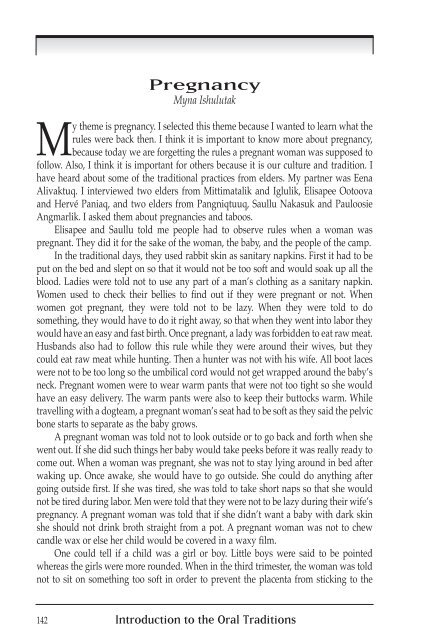Introduction-E
Introduction-E
Introduction-E
You also want an ePaper? Increase the reach of your titles
YUMPU automatically turns print PDFs into web optimized ePapers that Google loves.
Pregnancy<br />
Myna Ishulutak<br />
My theme is pregnancy. I selected this theme because I wanted to learn what the<br />
rules were back then. I think it is important to know more about pregnancy,<br />
because today we are forgetting the rules a pregnant woman was supposed to<br />
follow. Also, I think it is important for others because it is our culture and tradition. I<br />
have heard about some of the traditional practices from elders. My partner was Eena<br />
Alivaktuq. I interviewed two elders from Mittimatalik and Iglulik, Elisapee Ootoova<br />
and Hervé Paniaq, and two elders from Pangniqtuuq, Saullu Nakasuk and Pauloosie<br />
Angmarlik. I asked them about pregnancies and taboos.<br />
Elisapee and Saullu told me people had to observe rules when a woman was<br />
pregnant. They did it for the sake of the woman, the baby, and the people of the camp.<br />
In the traditional days, they used rabbit skin as sanitary napkins. First it had to be<br />
put on the bed and slept on so that it would not be too soft and would soak up all the<br />
blood. Ladies were told not to use any part of a man’s clothing as a sanitary napkin.<br />
Women used to check their bellies to find out if they were pregnant or not. When<br />
women got pregnant, they were told not to be lazy. When they were told to do<br />
something, they would have to do it right away, so that when they went into labor they<br />
would have an easy and fast birth. Once pregnant, a lady was forbidden to eat raw meat.<br />
Husbands also had to follow this rule while they were around their wives, but they<br />
could eat raw meat while hunting. Then a hunter was not with his wife. All boot laces<br />
were not to be too long so the umbilical cord would not get wrapped around the baby’s<br />
neck. Pregnant women were to wear warm pants that were not too tight so she would<br />
have an easy delivery. The warm pants were also to keep their buttocks warm. While<br />
travelling with a dogteam, a pregnant woman’s seat had to be soft as they said the pelvic<br />
bone starts to separate as the baby grows.<br />
Apregnant woman was told not to look outside or to go back and forth when she<br />
went out. If she did such things her baby would take peeks before it was really ready to<br />
come out. When a woman was pregnant, she was not to stay lying around in bed after<br />
waking up. Once awake, she would have to go outside. She could do anything after<br />
going outside first. If she was tired, she was told to take short naps so that she would<br />
not be tired during labor. Men were told that they were not to be lazy during their wife’s<br />
pregnancy. A pregnant woman was told that if she didn’t want a baby with dark skin<br />
she should not drink broth straight from a pot. A pregnant woman was not to chew<br />
candle wax or else her child would be covered in a waxy film.<br />
One could tell if a child was a girl or boy. Little boys were said to be pointed<br />
whereas the girls were more rounded. When in the third trimester, the woman was told<br />
not to sit on something too soft in order to prevent the placenta from sticking to the<br />
142 <strong>Introduction</strong> to the Oral Traditions


